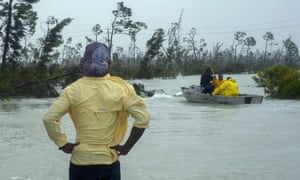The Bahamas, for those who live there, is simply a place to call home. For many Americans, it’s a dream vacation spot. But
Hurricane Dorian turned that dream into a nightmare. And the worst part is this is only the beginning. Because unless we confront the climate crisis, warming will turn more and more of our fantastic landscapes, cities we call paradise and other dream destinations into nightmarish hellscapes.
While the science has yet to come in on the specifics of just how much worse climate change made Dorian, we already know enough to say that warming worsened the damage. Because it’s not a coincidence that Dorian was one of the
strongest landfalling storms ever recorded in the Atlantic, with the
strongest sustained peak winds east of Florida, and the strongest ever to hit the Bahamas. This comes less than a year after Florida withstood the first landfalling category 5 hurricane in decades, on 5 October –
the latest ever in the season for a storm that strong.
On a basic physics level, we
know that warm waters fuel hurricanes, and Dorian was strengthened by waters well above average temperatures. The fact that climate change has heated up our oceans means Dorian was stronger than it would have been had we not spent the past 150 years dumping carbon pollution into the atmosphere. Sea surface temperatures were more than 1C warmer in the region where Dorian formed and strengthened than they were before we started burning fossil fuels.
Empirically, there is a
roughly 7% increase in maximum sustained wind speeds of the strongest storms for each 1C of warming. Since destructive potential is proportional to the third power of the wind speed, that corresponds to a 23% increase in potential wind damage. We saw that wind damage in the heartbreaking scenes of total devastation that have come in from the Bahamas.
We know that the warmer air gets, the more moisture it can hold – and then turn into flooding rains in a storm like this. And we know that as climate change has melted glaciers and ice around the world, that water has gone into the oceans. The extra water, along with the expansion of water as it’s warmed, means that sea levels have been raised. That means when a storm like Dorian makes landfall, there’s more water for its storm surge, already bolstered by stronger winds, to push further inland.
All that extra water makes hurricanes even more deadly, since it’s generally not the wind but the water that kills people. So although Dorian’s 220mph gusts were incredibly dangerous (
and sped up thanks to climate change), it was the 20-plus feet of storm surge and torrential rains that were the most destructive elements.
But there are two other ways that warming has probably worsened Dorian’s damage. One is that all that warm water allowed for the storm to ramp up quickly, undergoing what is known as rapid intensification as it exploded from a moderate category 2 to extreme category 5 over just two days.
A recent study has shown that this is getting more common because of climate change, and indeed the past few years have seen many similar examples of this effect in action. Dorian was the fourth category 5 storm in just the last four years.
So while climate change is making it so hurricanes can spin up quickly, it may also be slowing down how fast hurricanes move. Instead of moving across a coast and dissipating as normal, in recent years these storms are lingering longer in place, which means more flooding as the water piles up. For example, that’s exactly what we saw in Houston during Harvey, and in North Carolina during Florence.
Had Dorian been moving at a regular pace of a few miles an hour, the devastation in the Bahamas would have been much less severe. But
because it sat in place, basically stationary, the damage has been catastrophic. Again, Dorian is far from unique in moving slowly, as
a study last year found a 10% decrease in speed for storms like this globally, while
a similar study found a 17% decrease along the east coast of the US. While neither of these studies directly tie that slowdown to climate change, the theory that climate change is changing the jet stream in ways that would lead to stalling storms
(a phenomenon one of us has researched) is growing increasingly convincing.
When all these factors combine in one storm, as it has for Dorian, it is truly a nightmare scenario – and a preview of the climate crisis to come. The only question is whether we have the foresight to address it.
Michael Mann is distinguished professor of atmospheric science at Pennsylvania State University. His most recent book, with Tom Toles, is The Madhouse Effect: How Climate Change Denial Is Threatening Our Planet, Destroying Our Politics, and Driving Us Crazy. Andrew Dessler is a professor of atmospheric sciences and holder of the Reta A Haynes chair of geosciences at Texas A&M University. His most recent book is the Science and Politics of Global Climate Change: A Guide to the Debate

No comments:
Post a Comment